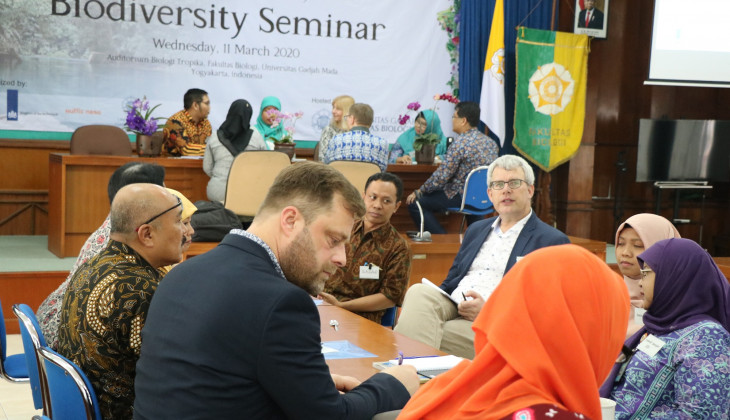In a series of visits by the Dutch King Willem-Alexander who was accompanied by Queen Maxima to Indonesia and Gadjah Mada University, a number of Dutch scientists had the opportunity to have discussions with UGM lecturers. A number of scientists since Wednesday (11/3) morning have held discussions at the UGM Faculty of Biology regarding biodiversity issues, at FKKMK on health and at the Faculty of Law, discussing social-humanities.
The dean of Faculty of Biology, Prof. Dr. Budi Setiadi Daryono, M.Agr.Sc., when welcoming the Dutch scientists said that the Faculty of Biology raised the discussion theme of biodiversity, detailing the problems of the Indonesian Biodiversity Index (IBI). It is hoped that the Indonesian Biodiversity Index can be a platform to measure the status of biodiversity and its impact on society.
“The measuring tool referred to as the Indonesian Biodiversity Index is very important for us to measure in every region, suburb, village, sub-district or district / city, or province, whether the biodiversity they have is still in good condition or is somewhat damaged or even completely damaged, “said Budi.
According to Budi, however, biodiversity is the initial capital to be able to work in a good and healthy environment. This is because humans need oxygen from the environment, hence if the environment around them is damaged, diversity will also decrease.
“For example, Jakarta has a slightly reduced index, so there must be efforts from the regional government and the central government to increase the diversity index, for example by planting lots of trees or controlling floods and so on,” he said.
As chairman of the Indonesian Biological Consortium (KOBI), he hopes that regions such as Papua and East Kalimantan, can be rewarded incentives. This is because the two areas produce a substantial amount of oxygen and biodiversity, because of areas like these, various herbs such as medicines can be produced.
“Incentives should be given for areas that can maintain and increase biodiversity. Like what KOBI does every year, giving biodiversity awards or a kind of Kalpataru to individual, group figures, or communities that focus on developing Indonesian biodiversity,” he said.
He hopes that the meeting with 15 scientists from various universities in the Netherlands will continue with real cooperation between researchers of the two countries, because KOBI currently has 331 study programs that are members from all over Indonesia from Sabang to Merauke.
“Hence this cooperation can be developed easier in biology, biotechnology, and microbiology study programs in Indonesia. This includes cooperation in zebrafish for biomedical development because rabbits, white rats and goats for experimental animals are currently expensive,” he said.
Deputy Dean for Research, Community Service and Cooperation, Faculty of Biology, Dr. Eko Agus Suyono, M.App.Sc., added that it is time for Indonesia and several universities in the Netherlands to develop the Indonesian Biodiversity Index. Until now, Indonesia does not yet have an Indonesian Biodiversity Index.
That way, IBI programs can be collaborated with Indonesian and Dutch universities, especially related to biodiversity research. This will certainly be a good synergy and research in the field of biodiversity will develop as well as be able to be linked to the Indonesian Biodiversity Index.
“Then we can see how good or damaged a biodiversity is. In terms of biodiversity, we are second only to Brazil. Indonesia does not have an IBI while the Netherlands already has an existing index. We can learn from them, even though it doesn’t have to be exactly the same, “he added.
Meanwhile, Dr. Bambang Retno Aji from the Animal Development Structure Laboratory added that currently UGM is collaborating with Leiden University in developing zebrafish fish facilities. According to him, through the facilities that have been initiated since 2015, 10 types of zebrafish have successfully been developed at UGM.
“The purpose of this facility is for testing as an organism model in research related to biodiversity as well as the medical field and other fields of science. The hope is that at the end of 2020 the zebrafish facility can function optimally and can be used by UGM academics as well as researchers from outside the university and also partners in Leiden,” he said.
Source: https://ugm.ac.id/id/berita/19118-ugm-dan-belanda-sepakat-bangun-indeks-biodiversitas-indonesia



